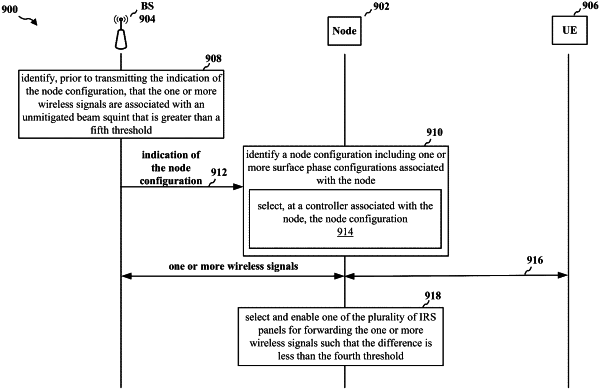| CPC H04W 16/28 (2013.01) [H04W 40/06 (2013.01); H04W 72/0453 (2013.01)] | 30 Claims |

|
1. An apparatus for wireless communication at a node, comprising:
memory; and
at least one processor coupled to the memory and configured to:
identify a node configuration including one or more surface phase configurations associated with the node; and
forward, from a base station to a user equipment (UE), or from the UE to the base station, one or more wireless signals, wherein the forwarded one or more wireless signals are associated with a beam squint less than a first threshold, and at least one of:
identify a length or a width of an enabled subarea of an intelligent reflecting surface (IRS) panel associated with the node based on a minimization of a function, and the function is associated with at least one of a delay spread associated with the one or more wireless signals, a bandwidth associated with the one or more wireless signals, a penalty term, a total energy reflected by the IRS panel, or an area of the enabled subarea of the IRS,
select and enable one of a plurality of IRS panels for forwarding the one or more wireless signals such that a difference between an angle of incidence at the node associated with the one or more wireless signals and an angle of reflection at the node associated with the one or more wireless signals is less than a second threshold, or
wherein the node is associated with the plurality of IRS panels or a plurality of IRS panel subareas concurrently enabled for forwarding the one or more wireless signals, the one or more surface phase configurations include a plurality of surface phase configurations for the plurality of IRS panels or the plurality of IRS panel subareas, and each of the plurality of IRS panels or the plurality of IRS panel subareas is associated with a respective one of the plurality of surface phase configurations based on a respective part of the bandwidth associated with the one or more wireless signals.
|